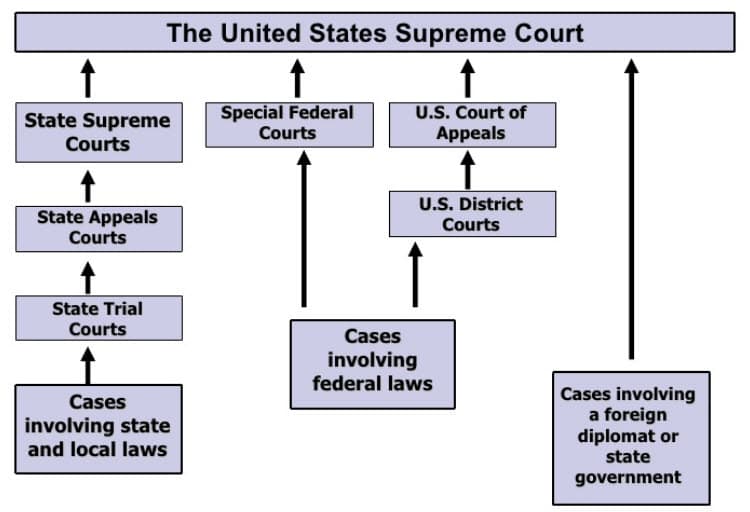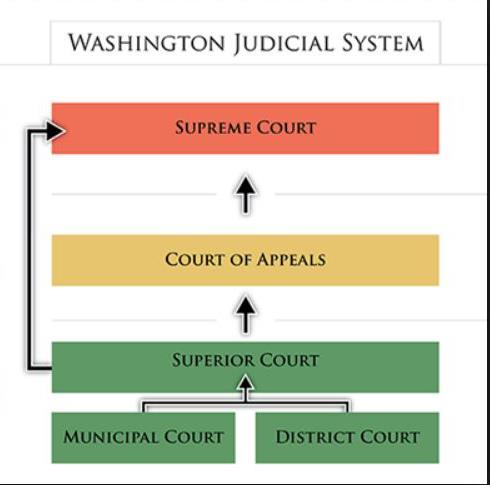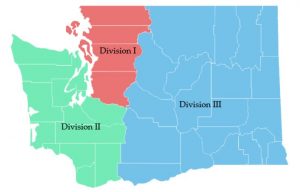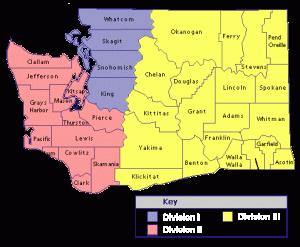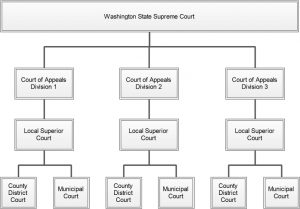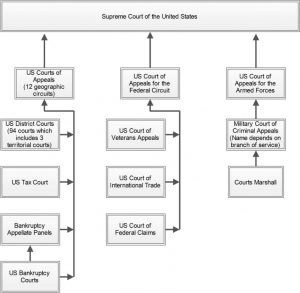Understanding the concept of a statute of limitations is important for the professional process server. Failure to understand this concept, and to take it into account in the correct set of circumstances, could lead to considerable embarrassment at the least and being forced out of business and into bankruptcy at the most.
Black’s Law Dictionary provides the following definition and explanation.
- A statute establishing a time limit for suing in a civil case, based on the date when the claim accrued (as when the injury occurred or was discovered). The purpose of such a statute is to require diligent prosecution of known claims, thereby providing finality and predictability in legal affairs and ensuring that claims will be resolved while evidence is reasonably available and fresh. Also termed nonclaim statute. “Statutes of limitation, like the equitable doctrine of laches, in their conclusive effects are designed to promote justice by preventing surprises through the revival of claims that have been allowed to slumber until evidence has been lost, memories have faded, and witnesses have disappeared.” Order of R.R. Telegraphers v. Railway Express Agncy, 321 U.S. 342, 389-49, 64 S.Ct. 582,586 (1944).
- A statute establishing a time limit for prosecuting a crime, based on the date when the offense occurred. Cf. Statute of Repose. “The purpose of a statute of limitations is to limit exposure to criminal prosecution to a certain fixed period of time following the occurrence of those acts the legislature had decided to punish by criminal sanctions. Such a limitation is designed to protect the individuals from having to defend themselves against charges when the basic facts have become obscured by the passage of time and to minimize the danger of official punishment because of acts in the far-distant past. Such a time limit may also have the salutary effect of encouraging law enforcement officials promptly to investigate suspected criminal activity.” Toussie v United States, 397 U.S. 112, 90 S.Ct. 858 (1970).
There are a number of statutes of limitation in Washington law. It is not unusual to hear them simply referred to as “the statute” as in “The statute has run”, meaning the last day of the statute of limitations has passed. Here are some statutes of limitations (in whole or in part) about which a professional process server should be aware.
- All claims or causes of action based on intentional conduct brought by any person for recovery of damages for injury suffered as a result of childhood sexual abuse shall be commenced within the later of the following periods:
- Within three years of the act alleged to have caused the injury or condition;
- Within three years of the time the victim discovered or reasonably should have discovered that the injury or condition was caused by said act; or
- Within three years of the time the victim discovered that the act caused the injury for which the claim is brought.
- Prosecution for criminal offenses shall not be commenced after the periods prescribed in this section.
- The following offenses may be prosecuted at any time after their commission;
- Murder;
- Homicide by abuse
- The following offenses shall not be prosecuted more than ten years after their commission;
- The following offenses may be prosecuted at any time after their commission;
f. Bigamy shall not be prosecuted more than three years after the time specified in RCW 9A.64.080.
h. No other felony may be prosecuted more than three years after its commission;
RCW 4.56.190 (in part)
The real estate of any judgment debtor, and such as the judgment debtor may acquire, not exempt by law, shall be held and bound to satisfy any judgment of the district court of the United States rendered in this state and any judgment of the supreme court, court of appeals, superior court, or district court of this state, and every such judgment shall be a lien thereupon to commence as provided in RCW 4.56.200 and to run for a period of not to exceed ten years from the day on which said judgment was entered unless the ten-year period is extended in accordance with RCW 6.17.020(3).
RCW 6.17.020 (in part)
- Except as provided in subsections (2), (3), and (4) of this section, the party in whose favor a judgment of a court has been or may be filed or rendered, or the assignee or the current holder thereof, may have an execution, garnishment, or other legal process issued for the collection or enforcement of the judgment at any time within ten years from entry of the judgment or the filing of the judgment in this state.
RCW 4.16.040 (in whole)
The following actions shall be commenced within six years:
- An action upon a contract in writing, or liability express or implied arising out of a written agreement.
- An action upon an account receivable incurred in the ordinary course of business.
- An action for the rents and profits or for the use and occupation of real estate.
RCW 4.16.080 (in part)
The following actions shall be commenced within three years:
2. An action for taking, detaining, or injuring personal property, including an action for the specific recovery thereof, or for any other injury to the person or rights of another not hereinafter enumerated;
RCW 7.72.060 (in part)
Length of time product sellers are subject to liability.
- Useful safe life.
- Except as provided in subsection (1)(b) hereof, a product seller shall not be subject to liability to a claimant for harm under this chapter if the product seller proves by a preponderance of the evidence that the harm was caused after the product’s “useful safe life” had expired.
3. Statute of limitation. Subject to the applicable provisions of chapter 4.16 RCW pertaining to the tolling and extension of any statute of limitation, no claim under this chapter may be brought more than three years from the time the claimant discovered the harm and its cause.
Obviously an understanding of how time is computed is vital to the understanding of a statute of limitations. There is a section of the course which deals with precisely that subject but a brief mention here is valuable.
RCW 1.12.040 (in whole)
Computation of time. The time within which an act is to be done, as herein provided, shall be computed by excluding the first day, and including the last, unless the last day is a holiday, Saturday, or Sunday, and then it is also excluded.
CR 6(a) (in whole)
Computation. In computing any period of time prescribed or allowed by these rules, by the local rules of any superior court, by order of court, or by any applicable statute, the day of the act, event, or default from which the designated period of time begins to run shall not be included. The last day of the period so computed shall be included, unless it is a Saturday, a Sunday or a legal holiday, in which event the period runs until the end of the next day which is neither a Saturday, a Sunday nor a legal holiday. Legal holidays are prescribed in RCW 1.16.050. When the period of time prescribed or allowed is less than 7 days, intermediate Saturdays, Sundays and legal holidays shall be excluded in the computation. Tell me more.
An Illustration
Let us suppose an automobile accident occurs on August 10, 2010. The first day, that is the day on which the accident occurred, is not counted as part of the three years (RCW 4.16.080(2) above) which determines the ending date of the statute. Instead, August 11th is day one and therefore August 10, 2013, is the termination date of the statute. A slight grace is allowed if the last day (08-13-2013) happens to fall on a holiday, Saturday, or Sunday. If it does then the last day of the statute falls on the next day which is not a holiday, Saturday, or Sunday. There are situations where these extra few days can make a difference between service being obtained and a case proceeding or the case being dismissed because of the passage of the statute.
Statutes of limitation have enormous implications for process servers. They are perhaps the single most important reason professional process servers carry errors and omissions (E&O) insurance. One of the worst situations in which a server can find himself is to be still in possession of service documents when the statute passes. It is not unusual for the server’s client to realize the case against the original defendant is now out of reach and, rightly or wrongly, to look to the server to make up for that loss.
It is vital for process servers to have a system in place which monitors assignments with close statutory deadlines. Often, as explained fully elsewhere in this course, there are alternative means of service which may be used to serve documents on even the most elusive servee. Here are some hints and strategies which will help avoid problems relating to statutes of limitations.
- Learn how to read the complaint so as to understand the type of case and to identify any important deadlines.
- Develop a basic understanding of the different types of cases you are asked to serve.
- Know the common statutes of limitation (such as RCW4.16.080(2)).
- Recognize situations which might be unusual and know how to look up information about them.
- Communicate regularly with your client about the current status of each assignment.
- Familiarize yourself with the requirements for different types of alternative service.
- Document everything you do.
- Understand the meaning of diligence and its application to service of process.
- Work all assignments on a regular basis or know the reason why they aren’t being attempted.
This quiz is for logged in users only.


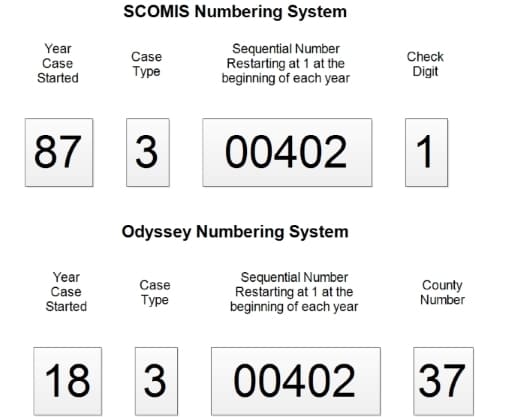
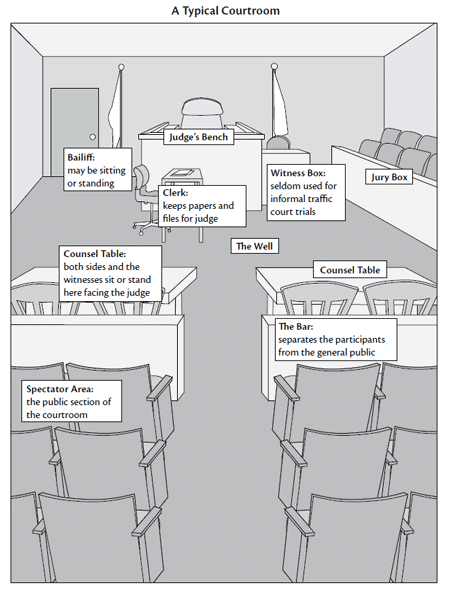 This is a rough diagram of a typical courtroom in the state of Washington. Courtrooms vary a great deal from city to city and county to county but they all have the same basic structure.
This is a rough diagram of a typical courtroom in the state of Washington. Courtrooms vary a great deal from city to city and county to county but they all have the same basic structure.